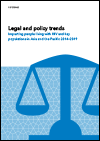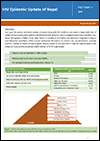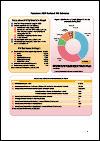What's New
Displaying results 611 - 620 of 4913

Resource | Publications,
The checklist and reference list is meant to complement and build on the most recent normative guidelines produced by UNAIDS Cosponsors and the Secretariat and not to replace them. The checklist has built-in hyperlinks for such guidelines for easy reference. The checklist and reference list has two parts: high-level cross-cutting content (Part A) and specific programme content (Part B).

Resource | Publications,
The purpose of this document is to provide guidance to national AIDS programmes and partners on the use of indicators to measure and report on the country HIV response.

Resource | Publications,
The COVID-19 vaccines under development or approved by regulators are believed to be safe for most people, including people living with HIV.

Resource | Publications,
This report provides a summary of key developments in the legal environment for HIV responses in Asia and the Pacific. It is the product of a desk review conducted for UNAIDS and the United Nations Development Programme (UNDP) in 2019. The report highlights key trends and developments in laws affecting people living with HIV and key populations in Asia and the Pacific over the five-year period 2014–2019.

Resource | Fact Sheets,
In December 2020, there were 1,076 confirmed HIV-positive individuals reported to the HIV/AIDS & ART Registry of the Philippines (HARP). Eighteen percent (198) had clinical manifestations of advanced HIV infection at the time of testing.

Resource | Publications,
The current HIV program is reaching KPs and PLHIV for prevention and treatment of HIV. The integrated intervention to KPs and providing HCV related activities like prevention, early diagnosis and providing treatment to cure HCV infection would be the cost-effective approach to decrease the burden of HCV among them. The availability of effective treatment – Direct - Acting Antiviral (DAA) has prevented HCV related consequences and cured from HCV infections. The pangenotypic DAA do not require genotyping of the virus and current WHO guidelines recommends that all HCV infected people are treated with minimal lab investigations and follow up. This recommendation helps us to combat Hep C related complications and prevent morbidities and mortalities and provide opportunity to treat clients at all kind of health facilities.

Resource | Fact Sheets,
Each year the annual estimated number of people living with HIV (PLHIV) is calculated in Nepal with help of analytical tools namely AIDS Epidemic Model (AEM) and Spectrum. Various program data as key population size, Nepal Demographic Health Survey data, trends of prevalence and behavioral data from integrated biological and behavioral surveillance (IBBS) survey, behavioral information on condom use, sexual behavior, injecting practice, number of clients etc and program data as people on ART and PMTCT data are used as input in the analytical tools and the annual estimated number of PLHIV is generated.

Resource | Fact Sheets,
2019 National HIV Estimates factsheet shows the information on HIV prevalence, HIV infections, trend of new infections and deaths.

Resource | Infographics,
This infographic enumerates the rights that sex workers deserve and should be entitled to.

Resource | Publications,
People who use drugs, especially people who smoke or inject drugs, face additional risks and vulnerabilities to COVID-19 infection compared to the general population. Maintaining services for this population and safeguarding funding for harm reduction is therefore crucial. The pandemic and related responses have affected harm reduction service provision and the lives of people who use drugs worldwide.
Understanding the impact of COVID-19 on harm reduction funding and service provision is essential for informing donor and government action as well as civil society advocacy.
This report and briefing summarise evidence from civil society in seven Asian countries (Cambodia, India, Indonesia, Nepal, Thailand, the Philippines and Vietnam) and provides recommendations to donors and governments on protecting harm reduction in the COVID-19 era.





